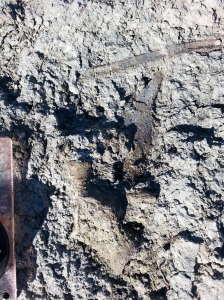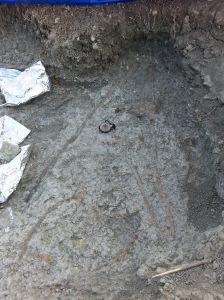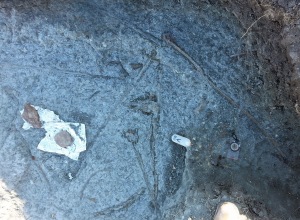

 Our newest skeleton is nicknamed “Mary” and is from an area called the transition zone from the Clyde (which is a terrestrial deposit) to the Leuders (which is a marine deposit). The Clyde is an old name for the geologic formation represented in the area we are now digging. Currently it is called the Waggoner Ranch formation, which falls within the Wichita group. So where we are digging is the uppermost or last stage in the Clyde/Waggoner Ranch formation before the arrival of the Leuders Limestone, which was deposited by an ocean. Fast forward and we see the Leuders disappear, meaning the ocean recedes and we see a return to the land or terrestrial ecosystems of the Arroyo formation which is within the Clearfork group. So in a nutshell we see Dimetrodons on land, then sharks in the ocean, then back to Dimetrodons on land. Formation wise, it is Waggoner Ranch is older than Leuders, which is in turn older than the Arroyo.
Our newest skeleton is nicknamed “Mary” and is from an area called the transition zone from the Clyde (which is a terrestrial deposit) to the Leuders (which is a marine deposit). The Clyde is an old name for the geologic formation represented in the area we are now digging. Currently it is called the Waggoner Ranch formation, which falls within the Wichita group. So where we are digging is the uppermost or last stage in the Clyde/Waggoner Ranch formation before the arrival of the Leuders Limestone, which was deposited by an ocean. Fast forward and we see the Leuders disappear, meaning the ocean recedes and we see a return to the land or terrestrial ecosystems of the Arroyo formation which is within the Clearfork group. So in a nutshell we see Dimetrodons on land, then sharks in the ocean, then back to Dimetrodons on land. Formation wise, it is Waggoner Ranch is older than Leuders, which is in turn older than the Arroyo.
The age of the fossils is not clear, this is very important. The majority of our Dimetrodon research has been within the younger Arroyo formation, which dates at 287 Million years. Because not enough research has been done on identifying exactly when the Clyde transitioned to the Leuders, putting a number on it is difficult. Identifying the exact layer that shows the transition is difficult. But we can guess that it’s a few million years at most older.
This transition is very important because it represents a huge fauna change from one period of time to another, and more importantly the extinction of older species and the emergence of new species. This was the dark age of Dimetrodon evolution with a ton of unanswered questions. What was happening? How and why did they evolve? Some of the old Paleo greats, such as Edward Drinker Cope, Alfred Sherwood Romer, and E.C. Case, all huge forerunners in the exploration of the Permian in Texas, hinted at a big Dimetrodon transition. They suspected there was something going on in the Dimetrodon families but couldn’t really prove it. This was because not a lot of good skeletons had been found; only a few. Their suggestion was the occurrence of a formidable extinction that resulted in one or two Dimetrodons surviving into the next formation.
One of the important changes we see in the terrestrial ecosystem transition is the change in soil color. The Clyde is composed of classic Wichita Group gray clays. Our site is gray clay that represents the last of the classic Wichita Group fauna. In the next terrestrial ecosystem, the Arroyo formation of the Clearfork group, the clays are now oxidized and stained blood red. This is a huge ecosystem change. Big fauna change. Effected everybody, and especially Dimetrodons.
From the evidence dating back to the early 1900’s from lots of great Arroyo skeletons and lots of early to mid Waggoner/Clyde skeletons, Dimetrodons evolved pretty quick. In a nutshell, we see our newest skeleton Mary as a potential transition species that displays elements of multiple species that occur later. The fin was a big transition from pencil thin and straight fin spines to thicker, wavier spines that lean backward. So why did the fin expand backwards?? Greater display? Makes sense, the fins evolved quicker than any other part of the body. In the Arroyo, it’s easy to identify a Dimetrodon grandis and a Dimetrodon loomisi; grandis is BIG. Thick massive spines, huge teeth. Robust. Grandis also has short, stocky vertebrae. Much like Dimetrodon giganhomogenes who is in the Arroyo as well. Loomisi is much more gracile. Slender spines, sharper narrower teeth. Longer neck. Long vertebrae. The long neck is important. In our Clyde specimen, we see a long neck. But her back vertebrae are short. We see a mix of two species there. Plus the Mary specimen has very verrrrrry long fin spines that are straight as an arrow, which is a classic form in the Clyde formation. No backwards lean to them yet. Great evidence there that it hasn’t approached evolution yet. Think about it this way: Today we have lions and cheetas. Go back 10 million years from today and you see an animal that looks a lot like both. Once they started to evolve they split into different types of cats.
So, we don’t know what species Mary is, which makes it exciting. Mary could be a new species or one that is a transitional species identified by paleontologists from the early 1900’s, the latter of the two is always the most likely. Our goal with this is to finally have an excellent Dimetrodon species that is representative of the last sample of vertebrates in the Clyde before a possible extinction and subsequent rapid evolution of the animal. We can hopefully finally answer the question of why the Dimetrodon species of the Arroyo formation look the way they do and how they got there through evolution. Ultimately we can prove the old guys from the turn of the 20th Dimetrodon extinction did occur followed by a rapid evolution.